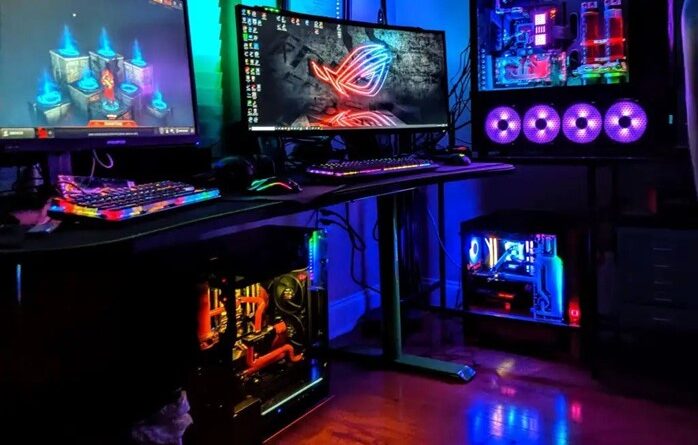Tech and Gaming: The Fusion of Technology and Entertainment
Introduction:
The world of technology and gaming has come a long way, with advancements in both fields constantly pushing the boundaries of what is possible. In this blog, we will explore the fascinating intersection of technology and gaming, discussing the latest developments, reviews, and trends in the gaming industry.

Tech and Gaming Overview
The History of Gaming Technology:
Origins:Gaming’s roots trace back to the early 1950s with simple games like “Tennis for Two.” The evolution continued with mainframe computers and arcade games in the ’60s and ’70s.
Home Gaming:The late ’70s and early ’80s saw the rise of home gaming with consoles like the Atari 2600, pioneering the industry’s growth.
The Evolution of Gaming Consoles and Platforms:
Console Wars:The ’90s witnessed fierce competition between Nintendo, Sega, and Sony. The release of the PlayStation in 1994 marked a significant shift towards disc-based gaming.
Online Gaming:The 2000s introduced online gaming with Microsoft’s Xbox Live and Sony’s PlayStation Network. Multiplayer experiences and digital distribution became central to the gaming landscape.
Mobile Gaming:The rise of smartphones in the late 2000s transformed gaming, making it more accessible. Mobile platforms became dominant with casual and immersive games.

The Role of Technology in Enhancing Gaming Experiences:
Graphics and Processing Power:Advancements in graphics cards and processing units led to realistic visuals and immersive gaming environments. Technologies like ray tracing further enhance realism.
Virtual Reality (VR) and Augmented Reality (AR): VR and AR technologies provide unprecedented levels of immersion, allowing players to step into virtual worlds or overlay digital content onto the real world.
Cloud Gaming:The emergence of cloud gaming services eliminates the need for high-end hardware. Services such as Google Stadia and Xbox Cloud Gaming enable gamers to stream their favorite titles straight to their devices
Trending Gaming Developments:
Virtual Reality (VR) and Augmented Reality (AR) in Gaming:
Virtual Reality (VR): VR technology immerses players in a computer-generated environment, enhancing sensory experiences. Headsets like Oculus Rift and PlayStation VR redefine gaming by providing a more immersive and interactive platform.
Augmented Reality (AR) : technology seamlessly integrates digital elements into real-world environments, enhancing the user experience with immersive overlays. Games like Pokémon GO demonstrated the potential for AR in blending digital content with the physical environment, creating engaging and dynamic experiences.

The Rise of Mobile Gaming:
Accessibility:Mobile gaming has become a global phenomenon due to the widespread availability of smartphones. It offers accessibility and convenience, allowing users to play games anytime, anywhere. Diverse Game Genres:The mobile gaming landscape encompasses a wide range of genres from casual to hardcore, appealing to a broad audience. Games like Among Us and Genshin Impact showcase the diversity and depth of mobile gaming experiences.

Cloud Gaming and Its Potential Impact on the Industry
Streaming Services:Cloud gaming enables users to play games without the need for high-end hardware by streaming content from remote servers. Platforms like Google Stadia, Xbox Cloud Gaming, and NVIDIA GeForce Now are at the forefront of this trend.
Reduced Hardware Barriers:Cloud gaming has the potential to democratize gaming by eliminating the need for expensive gaming consoles or PCs. This can broaden access to high-quality gaming experiences for a more extensive and diverse audience.
Challenges and Opportunities:While cloud gaming faces challenges like internet infrastructure and latency issues, ongoing advancements in technology and infrastructure improvements hold the promise of transforming the gaming industry.

FAQs and Common Challenges:
1.How do game developers create immersive experiences?
Storytelling and World-building: Crafting compelling narratives and intricate game worlds contribute to immersive experiences. Engaging plots and well-defined settings captivate players and enhance their connection to the game.
Graphics and Sound Design: High-quality graphics and realistic soundscapes elevate immersion. Attention to detail in visuals and audio can transport players into the game’s universe, heightening the overall experience.
Interactivity and Gameplay Mechanics:Interactive elements and innovative gameplay mechanics encourage player engagement. Providing meaningful choices and challenges fosters a sense of agency, making the gaming experience more immersive.
2.What are the challenges faced by the gaming industry?
Technological Advancements: Staying abreast of rapid technological developments poses a challenge. Game developers must continually upgrade their skills and adapt to new platforms, hardware, and software to remain competitive.
Monetization and Microtransactions: Balancing profitability with player satisfaction is a constant challenge. The industry grapples with finding fair and sustainable monetization models while avoiding negative impacts on the player experience.
Diversity and Inclusion: Achieving diversity and inclusion in games remains an ongoing challenge. The industry is striving to represent a more diverse range of characters and perspectives, reflecting the broader gaming community.
3.How can gamers stay updated on the latest trends and news?
Gaming News Websites:Regularly visit reputable gaming news websites for the latest updates, reviews, and announcements. Sites like IGN, Polygon, and Kotaku provide comprehensive coverage of the gaming industry.
Social Media:Follow gaming influencers, developers, and official accounts on platforms like Twitter, Instagram, and YouTube. Social media is a quick and interactive way to receive real-time updates and insights.
Gaming Conventions and Events: Attend virtual or physical gaming events and conventions. Events like E3 and Gamescom showcase the latest game releases, innovations, and industry trends.
for more https://technowritters.com/index.php/2024/03/01/what-is-technology-transfer/
SpinBot IceDot semi-conducter based Mobile Cooler for Android/iOS Smartphones Gaming Accessory Kit Gadgetshttps://www.flipkart.com/spinbot-icedot-semi-conducter-based-mobile-cooler-android-ios-smartphones-gaming-accessory-kit/p/itm8f42cae525fad?pid=ACCG4VN2HTYEARVZ&lid=LSTACCG4VN2HTYEARVZFMKLS2&marketplace=FLIPKART&q=gaming+gadgets&store=search.flipkart.com&srno=s_1_1&otracker=search&otracker1=search&fm=Search&iid=en_h_gnjE8LdI9_SJXWsWVA1a5zfUh45CcAF-jYDaZEzObIfh2hreuUvTLO4Xwg4fTvlqgnNxyqn4uU45ErE7S4yA%3D%3D&ppt=sp&ppn=sp&ssid=n5v20etcn40000001709640194165&qH=f1a262ef9d815178
Conclusion:
The gaming industry is constantly evolving, driven by advancements in technology and the creativity of game developers. As a result, gamers can look forward to an exciting future filled with innovative experiences and groundbreaking games. Stay tuned to our blog for the latest news, reviews, and insights into the fascinating world of technology and gaming.


Pingback: Decoding the Laptop Market: Your Ultimate Guide to the Best Laptops Under 50k-60k - Technowritters